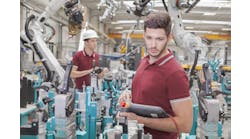Jim Montague is the executive editor for Control. Email him at [email protected].
Traditional machine safety is a lot like Ziebart or Rusty Jones. Remember those long-ago rustproofing services? You'd buy a new or at least late-model car, take it to one of their local shops, and they'd drill a bunch of holes in the body and spray in a rust-inhibiting coating. It seemed like a good idea at the time.
Well, I took a new 1987 Toyota Tercel to a local Ziebart, and it got the usual treatment, which I found out included sticking little plastic buttons into and over the new holes inside the door panel, rear hatch and other locations. Even then, this seemed a little goofy to me. I mean, punching holes in a new car didn't seem like a logical way to prevent rust. Why not apply the anti-rust stuff during assembly and avoid all the holes? My concern only grew as the years went by, and I routinely saw rainwater dripping out of the drill holes and little, spidery trails of rust start branching out from under the plastic buttons. Terrific.
I'd bet the whole rust-proofing industry got started because the automakers weren't doing it—given all the rusted hulks we used to see in moister parts of North America. So I'd also guess that Ziebart and other shops and their aftermarket dried up once the car builders started adding some of their own auto-body preservatives before or during assembly.
Similar to the rustproofing saga, machine safety used to be mostly a difficult and often ineffective afterthought. Gates, guards, E-stops, light curtains and other protective devices were added after machines were built, but were so cumbersome that operators frequently bypassed them. In recent years, some standards, such as the National Fire Protection Assn's NFPA-79 rules, have enabled safety and control communications on the same network. This enabled the advent of dual-processor safety PLCs and other components that can be designed into machines and production lines before they're built, and help set up safe zones, safe speeds and safe directions in machines. These capabilities allow operators to interact much more closely with machines with little or no risk of injury or having to completely power down.
The main trick is to plan ahead, include safety functions in initial designs and get protections integrated before equipment is assembled and tested. Many machine builders have adopted these principles and the devices and standards that support them. However, others have been slower to get on board because they've always built and guarded their machines a certain way, or they don't know which standards apply to them, or they're unaware how easy it is to apply new safety PLCs and other components. Changing mindsets is a lot harder than revising designs, and that's why useful foresight is always in short supply.
Also Read: What’s old and what’s new with machine safety?
One thing that could help reluctant builders get over the new safety learning curve a lot faster would be to make today's standards much more available and accessible than they've been in the past. Whenever I cover machine safety, I'm always encouraged by everyone saying how important it is to get builders, system integrators and end users more educated about safety, but then I'm stunned at how few specific details there are about what the primary ISO, IEC, ANSM, NFPA, UL, RIA and other standards require, where they must be applied, and how to comply with them. Most sources say builders must either shell out hundreds or thousand of dollars for their own copies of the safety standards or pay system integrators or certified consultants who are familiar with the standards to advise them.
I know standards organizations must be compensated for the resources they spend on developing safety standards. However, given the paltry details usually available, I also know they could do a lot more to provide basic guidelines and encouragement to builders seeking to add safety earlier in their machine design and prototyping processes.
Of course, this improved outreach by many of the major safety organizations will be even more crucial as the standards themselves evolve and are updated. For example, ISO 13849 just recently took over for EN 954, and builders need to know how to calculate safety performance levels, and not just how to fit into former safety categories. In fact, efforts are already underway to combine ISO 13849 with IEC 62061, and builders need more input on how this will affect them.
Heck, many suppliers and governments might be willing to fund greater dissemination of safety standards to builders because it would mean greater use of safety PLCs and other products, and prevent some tragic injuries at the same time. Just like with rust-proofing, safety will eventually get where it needs to go, but why not give it some help along the way?





